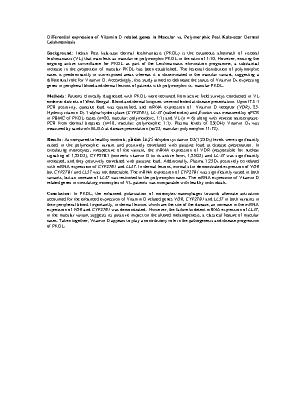Differential expression of Vitamin D related genes in Macular vs. Polymorphic Post Kala-azar Dermal Leishmaniasis
|
Tue10 Apr05:00pm(15 mins)
|
Where:
Stream 1 - Edward Llwyd 0.26 Biology Main
Speaker:
|
Authors
S Moulik1; A Dighal1; R Sengupta1; D Mukhopadhyay1; S Mukherjee1; S J Choudhuri2; M Chatterjee1;1 Institute of PG Medical Education and Research, India; 2 Ranaghat SD Hospital, Kolkata, India
Discussion
Background: Indian Post kala-azar dermalleishmaniasis (PKDL) is the cutaneous aftermath of visceral leishmaniasis (VL) that
manifests as macular or polymorphic PKDL in the ratio of 1:10. However, ensuing
the ongoing active surveillance for PKDL as part of the Leishmaniasis
elimination programme, a substantial increase in the proportion of macular PKDL
has been established. The lesional distribution of polymorphic cases is
predominantly in sun-exposed areas whereas it is disseminated in the macular
variant, suggesting a differential role for Vitamin D. Accordingly, this study aimed to delineate the status of Vitamin D3
expressing genes in peripheral blood and dermal lesions of patients with polymorphic
vs. macular PKDL.
Methods: Patients clinically
diagnosed with PKDL were recruited from active field surveys conducted in VL
endemic districts of West Bengal. Blood and dermal biopsies were collected at
disease presentation. Upon ITS-1 PCR positivity, parasite load was quantified,
and mRNA expression of
Vitamin D receptor (VDR),
25-Hydroxyvitamin D3 1-alpha-hydroxylase (CYP27B1), LL-37
(cathelicidin) and β-actin was
measured by qPCR in PBMC of PKDL cases (n≤20, macular: polymorphic, 1:1) and VL
(n ≤ 6) along with reverse transcriptase-PCR from dermal biopsies (n≤10, macular:
polymorphic 1:1). Plasma
levels of 25(OH) Vitamin D3 was measured by sandwich ELISA at
disease presentation (n≤23, macular: polymorphic 11:12).
Results: As compared to healthy controls, plasma 1α,25-dihydroxyvitamin D3(1,25D3) levels
were significantly raised in the
polymorphic variant and positively
correlated with parasite load at disease presentation. In circulating monocytes, irrespective of the variant, the mRNA expression
of VDR (responsible for nuclear signaling of 1,25D3), CYP27B1 (converts vitamin D to its active form, 1,25D3) and LL-37 was significantly increased, and they positively
correlated with parasite load. Additionally, Plasma 1,25D3
positively co related with mRNA expression of CYP27B1 and LL37. In dermal
lesions, normal skin demonstrated expression of VDR but CYP27B1 and LL37 was not detectable. The mRNA
expression of CYP27B1 was significantly
raised in both variants, but an increase of LL37
was restricted to the polymorphic cases. The mRNA expression of Vitamin D related genes in circulating
monocytes of VL patients was comparable with
healthy individuals.
Conclusion: In PKDL, the
enhanced polarization of monocytes-macrophages towards alternate activation
accounted for the enhanced expression of Vitamin D related genes VDR, CYP27B1
and LL37 in both variants in their
peripheral blood. Importantly, in dermal lesions which are the site of the
disease, an increase in the mRNA expression of VDR


